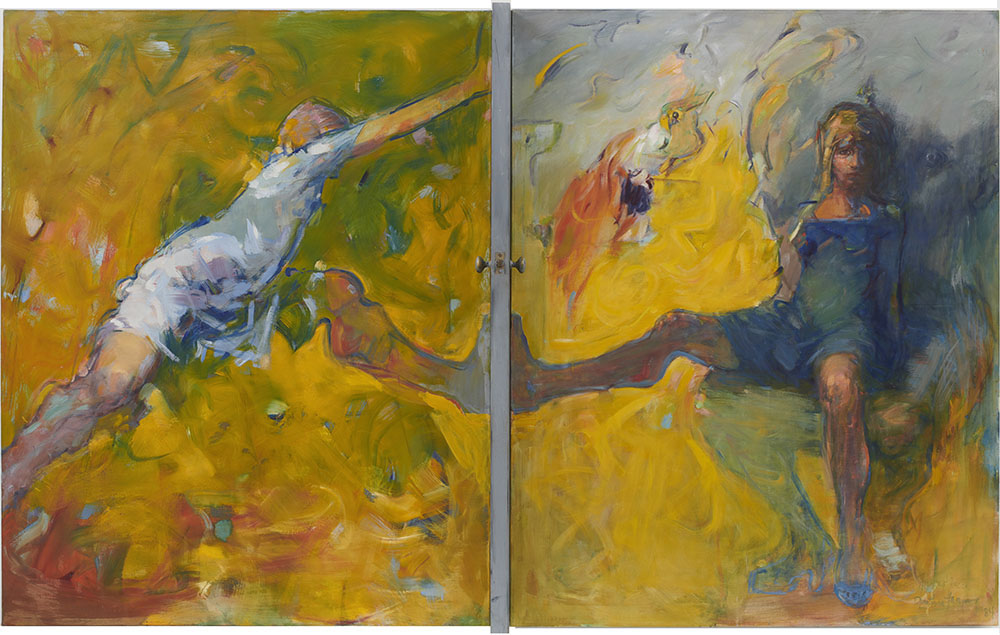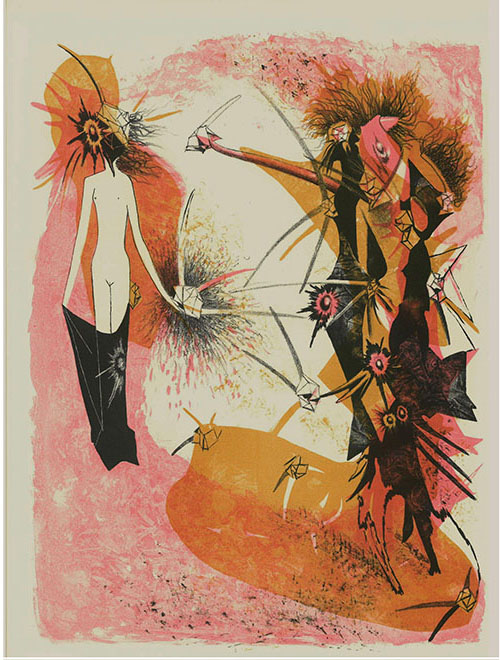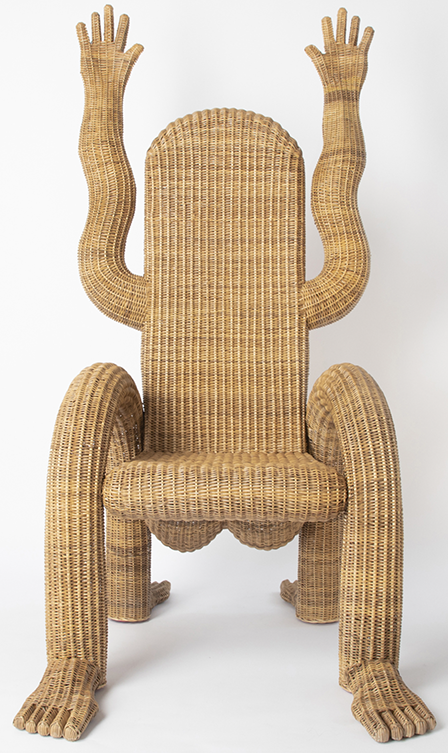Download: Dorothea Tanning @ Wendi Norris
by Lis Bensley

Adolescence is undoubtedly one of the most unsettling events humans experience. Marked as it is by the loss of naivete and innocence, raging hormones, personality and physical changes and the nebulous launch into adulthood, how could it be otherwise? It’s fitting, then, that Dorothea Tanning tackled the subject.
Tanning, one of the seminal surrealist painters of the past century, died at age 102 in 2012. One of her most famous works, Eine Kleine Nachtmusik (1943), depicts two young girls frolicking in a hallway of a hotel, one lost in dreams leaning against a closed door, her belly protruding as though pushing into womanhood, the other mesmerized by a giant sunflower lying on the carpet, her blonde hair flying straight over her head as though terrified or electrified by a door at the end of the hall opening to a world of flames or, perhaps, a sunrise. What could better speak to adolescence than this?
Musical Chairs, another Tanning masterpiece, also addresses this fraught interlude. In this 1951 work, Tanning captures a young girl just as she has fallen off her chair, landing in a flurry of golden drapery she possibly pulled down. Her back is arched sharply. Is she in pain or rapture, or both? As Amy Lyford writes in her comprehensive biography, Exquisite Dreams: The Art and Life of Dorothea Tanning, “She appears transported into another realm and lost in that experience.”
Many questions abound. Did she lose her balance? Did she slide off her chair out of boredom or a fit of pique, pulling down drapes to make a point? And how does she feel landing so abruptly on the ground? Answers remain elusive.

For the first time in 70 years, Musical Chairs is on view in the US at the Wendi Norris Gallery, in a show of the same title that pairs Tanning’s work with an array of surrealist-tinged contemporary furniture. Tanning’s portion of the exhibition features a beguiling mix of imagery. A large painting, Door 84, hangs in the front of the gallery. In the back can be seen two of Tanning’s costume designs for Momenta, a ballet, along with Fatala, a small painting, and Seven Deadly Perils, a suite of seven lithographs made while she was living in France (1949-1976) with her husband, Max Ernst.
The eclectic mix well represents an artist who resisted categorization. As she stated in a 1984 interview: “Am I a surrealist? Am I a sophist, a Buddhist, a Zoroastrian? Am I an extremist, an alchemist, a contortionist, a mythologist, a fantasist, a humorist? Must we artists bow our heads and accept a label without which we do not exist? I have no label except artist.”

Contrary to Tanning’s longstanding surrealist orientation, Door 84 (1984) leans more toward abstraction, a genre she explored later in her career. She and many surrealists used the motif as a kind of visual shorthand to denote alternative realities that could be accessed by examining the subconscious. Here, the door remains shut to those possibilities as two young women battle it out, each pushing hard against an actual door, a fragment of which divides the two scenes and whose edge (including doorknobs) protrudes from the center of the painting, creating a diptych. Both women seem determined to avoid seeing what’s on the other side, their resolute efforts palpable amid the loose, gestural brushwork. Even so, Surrealism rears its head: plopped beside one woman is an eye with three pupils and a parrot off to one side.
Musical Chairs also pays homage to Tanning’s work as a fashion illustrator and designer with two small ink and watercolor drawings (1947-48) depicting costumes for Momenta, a ballet that was never performed. Both feature another repeating Tanning motif: tassels. They reappear in Fatala, a small painting where a woman peers around a door that doubles as the cover of a life-sized book containing tassels and a blonde wig.
A suite of nine lithographs etched and conceived with the surrealist writer A. Pieyre de Mandiargues rounds out Tanning’s part of the show. Looking at them, I couldn’t help but marvel at the absurdity of her imagination. The scenes could have sprung from Alice Through the Looking Glass.

Aptly paired with Tanning’s work are five contemporary chairs, odd yet perfect companions. Nalgona, by Chris Wolston, is arguably the strangest of the bunch. Fabricated out of wicker and steel, it takes the form of a human body, arms thrown back, aghast that anyone might take a seat. Botolo High Chair, by Arflex, is anything but high. It’s a squat, fluffy lambskin-covered seat that practically begs to be occupied. Mother of Pearl Shell Chair by Rachel Shillander, a pearlescent bean bag shape that sparkles under gallery lights, is far more comfortable than it looks. Malde Chair, by Orior, and Sit, Set Chair, by Campagna for Roll & Hill, are less inviting as functional furniture, but they’re intriguing objects.
Though pairing furniture with Tanning’s work could also be viewed as enigmatic, that is exactly what Tanning would have liked. As she noted in an interview, “Anything that is ordinary and frequent is uninteresting to me, so I have to go in a solitary and risky direction. If it strikes you as being enigmatic, well, I suppose that’s what I wanted it to do.”
# # #
Dorothea Tanning: “Musical Chairs” @ Gallery Wendi Norris through May 4, 2024.
About the author: Lis Bensley is the award-winning author of The Glimpse, a novel about artists of the Abstract Expressionist era. Her articles have appeared in The New York Times, International Herald Tribune, The New Mexican, ArtNews, Elle Decor, Fine Cooking and other publications. She lives in Santa Cruz, CA.